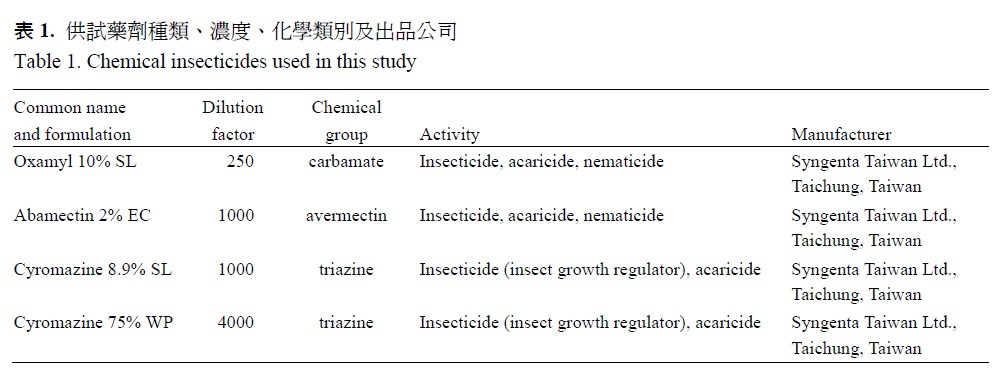All issues
Author:Ching-Chin Chien* and Shu-Chen Chang
Abstract:
Closterocerus okazakii (Kamijo) and Chrysocharis pentheus (Walker) are important native parasitoids of Liriomyza sativae Blanchard in Taiwan. In this study, seedlings of field bean (Phaseolus vulgaris var. communis Aeschers) infested with parasitoids or L. sativae were used to determine effect of insecticides (oxamyl SL, abamectin EC, cyromazine SL, and cyromazine WP) on C. okazakii and C. pentheus at different development stages under laboratory conditions. Results showed that all the three tested insecticides had a significant (p < 0.05) lethal effect on C. okazakii and C. pentheus in adult stage but no lethal effect on other development stages (egg, larva and pupa). When adult wasps were treated with insecticides for 24 hours, survival rates of female and male decreased by 62.9 and 7.1%, respectively, for abamectin in C. okazakii, 36.0 and 7.0%, respectively, for oxamyl in C. pentheus, whereas the others had no significant effects with decreased survival rates or significantly decreased by 4.0–8.2% only. The progeny of these two species of parasitoids decreased by 75.0–87.7% after the treatment of adults with either abamectin or cyromazine for 24 hours, and 50.6–58.3% by the treatment of adults with oxamyl. Among the three insecticides tested, abamectin was the most toxic insecticide for both parasitoid species. When adult wasps were treated with abamectin for 24 hours and released on untreated bean seedlings infested with hosts daily, the longevity of female wasps, longevity of male wasps, number of wasp progeny, and number of L. sativae killed by wasps decreased by 79.0–94.6, 61.7–67.5, 100 and 99.8–100%, respectively. In C. okazakii, treatment of adult wasps with both formulations of cyromazine resulted in 23.8% reduction of wasp progeny and treatment of adult wasps with oxamyl resulted in 30.2% reduction of female proportion. In C. pentheus, treatment of adult wasps with both formulations of cyromazine or oxamyl resulted in 42.4–52.5% reduction of wasp progeny and 21.9–34.5% reduction in the number of hosts killed by wasps. The percentage of hosts-killed increased 0.6 fold by the combined treatment of insecticide and C. okazakii, and 1.5 fold by the combined treatment of insecticide and C. pentheus, compared to the treatment of C. okazakii or C. pentheus alone. Abamectin was incompatible when used with both C. okazakii and C. pentheus, whereas oxamyl was incompatible with C. pentheus. The results suggest that cyromazine is less harmful to C. okazakii and C. pentheus and it can be used with these parasitoids for the control program of L. sativae.
Key words:Liriomyza sativae, Closterocerus okazakii, Chrysocharis pentheus, Insecticides, Development st ages
Download:![]() PDF Links
PDF Links
- 1. Development of Tractor-Mounted Seedling Transplanter for Sweet Potato
- 2. Synergistic Effect of Additional Gas on the Toxicity of Phosphine to Sitophilus oryzae and Sitophilus zeamais (Coleoptera: Dryophthoridae)
- 3. Effects of Temperature and Solar Radiation on Growth Traits and Plant Elements in Purple Leafy Sweet Potato

 Submit your manuscript
Submit your manuscript
 Guide for authors
Guide for authors